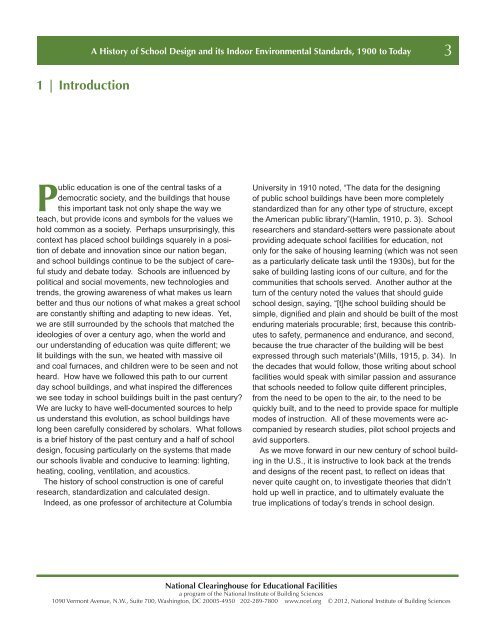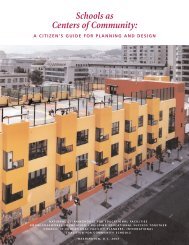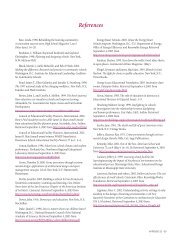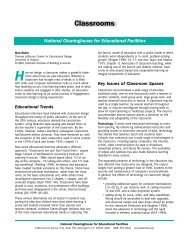A History of School Design and its Indoor - National Clearinghouse ...
A History of School Design and its Indoor - National Clearinghouse ...
A History of School Design and its Indoor - National Clearinghouse ...
You also want an ePaper? Increase the reach of your titles
YUMPU automatically turns print PDFs into web optimized ePapers that Google loves.
1 | Introduction<br />
A <strong>History</strong> <strong>of</strong> <strong>School</strong> <strong>Design</strong> <strong>and</strong> <strong>its</strong> <strong>Indoor</strong> Environmental St<strong>and</strong>ards, 1900 to Today<br />
P<br />
ublic education is one <strong>of</strong> the central tasks <strong>of</strong> a<br />
democratic society, <strong>and</strong> the buildings that house<br />
this important task not only shape the way we<br />
teach, but provide icons <strong>and</strong> symbols for the values we<br />
hold common as a society. Perhaps unsurprisingly, this<br />
context has placed school buildings squarely in a position<br />
<strong>of</strong> debate <strong>and</strong> innovation since our nation began,<br />
<strong>and</strong> school buildings continue to be the subject <strong>of</strong> careful<br />
study <strong>and</strong> debate today. <strong>School</strong>s are infl uenced by<br />
political <strong>and</strong> social movements, new technologies <strong>and</strong><br />
trends, the growing awareness <strong>of</strong> what makes us learn<br />
better <strong>and</strong> thus our notions <strong>of</strong> what makes a great school<br />
are constantly shifting <strong>and</strong> adapting to new ideas. Yet,<br />
we are still surrounded by the schools that matched the<br />
ideologies <strong>of</strong> over a century ago, when the world <strong>and</strong><br />
our underst<strong>and</strong>ing <strong>of</strong> education was quite different; we<br />
lit buildings with the sun, we heated with massive oil<br />
<strong>and</strong> coal furnaces, <strong>and</strong> children were to be seen <strong>and</strong> not<br />
heard. How have we followed this path to our current<br />
day school buildings, <strong>and</strong> what inspired the differences<br />
we see today in school buildings built in the past century?<br />
We are lucky to have well-documented sources to help<br />
us underst<strong>and</strong> this evolution, as school buildings have<br />
long been carefully considered by scholars. What follows<br />
is a brief history <strong>of</strong> the past century <strong>and</strong> a half <strong>of</strong> school<br />
design, focusing particularly on the systems that made<br />
our schools livable <strong>and</strong> conducive to learning: lighting,<br />
heating, cooling, ventilation, <strong>and</strong> acoustics.<br />
The history <strong>of</strong> school construction is one <strong>of</strong> careful<br />
research, st<strong>and</strong>ardization <strong>and</strong> calculated design.<br />
Indeed, as one pr<strong>of</strong>essor <strong>of</strong> architecture at Columbia<br />
University in 1910 noted, “The data for the designing<br />
<strong>of</strong> public school buildings have been more completely<br />
st<strong>and</strong>ardized than for any other type <strong>of</strong> structure, except<br />
the American public library”(Hamlin, 1910, p. 3). <strong>School</strong><br />
researchers <strong>and</strong> st<strong>and</strong>ard-setters were passionate about<br />
providing adequate school facilities for education, not<br />
only for the sake <strong>of</strong> housing learning (which was not seen<br />
as a particularly delicate task until the 1930s), but for the<br />
sake <strong>of</strong> building lasting icons <strong>of</strong> our culture, <strong>and</strong> for the<br />
communities that schools served. Another author at the<br />
turn <strong>of</strong> the century noted the values that should guide<br />
school design, saying, “[t]he school building should be<br />
simple, dignifi ed <strong>and</strong> plain <strong>and</strong> should be built <strong>of</strong> the most<br />
enduring materials procurable; fi rst, because this contributes<br />
to safety, permanence <strong>and</strong> endurance, <strong>and</strong> second,<br />
because the true character <strong>of</strong> the building will be best<br />
expressed through such materials”(Mills, 1915, p. 34). In<br />
the decades that would follow, those writing about school<br />
facilities would speak with similar passion <strong>and</strong> assurance<br />
that schools needed to follow quite different principles,<br />
from the need to be open to the air, to the need to be<br />
quickly built, <strong>and</strong> to the need to provide space for multiple<br />
modes <strong>of</strong> instruction. All <strong>of</strong> these movements were accompanied<br />
by research studies, pilot school projects <strong>and</strong><br />
avid supporters.<br />
As we move forward in our new century <strong>of</strong> school building<br />
in the U.S., it is instructive to look back at the trends<br />
<strong>and</strong> designs <strong>of</strong> the recent past, to refl ect on ideas that<br />
never quite caught on, to investigate theories that didn’t<br />
hold up well in practice, <strong>and</strong> to ultimately evaluate the<br />
true implications <strong>of</strong> today’s trends in school design.<br />
<strong>National</strong> <strong>Clearinghouse</strong> for Educational Facilities<br />
a program <strong>of</strong> the <strong>National</strong> Institute <strong>of</strong> Building Sciences<br />
1090 Vermont Avenue, N.W., Suite 700, Washington, DC 20005-4950 202-289-7800 www.ncef.org © 2012, <strong>National</strong> Institute <strong>of</strong> Building Sciences<br />
3










